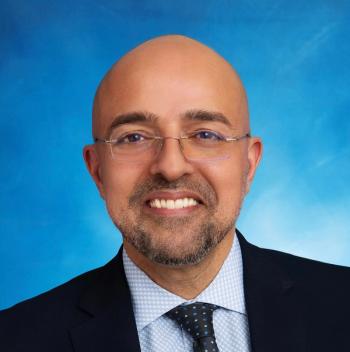
Telehealth and empathy: Mia Finkelston of Amwell talks about connecting with patients
In an interview with Chief Healthcare Executive, Amwell’s senior medical director talks about the opportunities of telemedicine and some of the hurdles for the industry.
As telemedicine is used more widely, some doctors are wondering if they can connect with patients in virtual visits with patients.
Just over half of all doctors (51%) said they thought telehealth would hurt their ability to express empathy, according to the “
The results astonished Mia Finkelston, senior medical director of Amwell, the telemedicine company based in Boston. She said there’s no reason doctors can’t convey empathy in a telehealth visit.
“I was shocked by that,” Finkelston said. “I personally think it’s easier. I really do. In a brick and mortar, I had so many distractions. I could have a knock on the door.”
“It comes down to being able to talk to people and listen to them,” she said.
- Related story:
Using telehealth to improve equity and access
In an interview with Chief Healthcare Executive, Finkelston talked about the ways clinicians can connect with patients in telemedicine, the possibilities for the industry and challenges to overcome.
“I don’t think all doctors are suited for telehealth medicine honestly, but I think you can learn how to get better at it, for sure,” Finkelston said. “Practice makes perfect.”
“It comes down to being able to talk to people and listen to them,” she said. (The story continues after the video.)
‘Let them talk’
In her role, Finkelston trains doctors in using telehealth. She said doctors should always assume it’s the patient’s first telehealth visit.
“You kind of want to go overboard making sure they are comfortable, they can hear you, they can see you,” Finkelston said. “Just assume they don’t know anything about a telehealth visit.”
Doctors can start connecting with patients right at the beginning of a visit. Rather than asking a patient about their sore throat, doctors should begin by asking patients why they needed the appointment. Give patients the space to talk about what’s bothering them.
“Let them talk for a little bit,” she said.
In a telehealth visit, clinicians need to demonstrate they are totally focused on their patients. Finkelston said it’s important for doctors to be in an office-like setting without distractions, such as pets running around. At Amwell, doctors are directed to wear their white coats.
Beyond the setting, doctors need to show they are fully engaged with what their patients are saying, even with simple gestures such as nodding or changing facial expressions. She said, “Are you really listening? Are you conveying that you’re listening?”
If doctors are taking notes or searching for information, they need to communicate that to patients, so the patients understand they are still being heard. “Let the patient know what you are doing.”
“I’ll often look things up when I’m talking to a patient. I’ll say, let me make sure that’s safe to take with the other medicine you’re using,” Finkelston said.
When it comes to empathy, patients are going to appreciate it if their doctor can also be real with them.
As Finkelston said, doctors could say, “That really stinks when you wake up with a sore throat and have to go to work. I totally understand that. Let’s be human for a bit there. I think those sort of common conversational pieces really are what’s going to make a successful visit.”
While doctors obviously can’t place a reassuring hand on their patient’s shoulder in a video visit, Finkelston said she will tell patients that she would offer a gentle touch if she could. “I often personally will say, if I was in the room with you, I’d put my hand on your shoulder. I literally do say that. Or if I was in the room with you, I’d want to hold your hand.”
In treating older patients in telehealth visits, Finkelston said she’ll often ask to speak with a spouse or family member who can make sure everything is being understood. If the patient is alone, Finkelston said she will ask the patient to touch base with family or friends and encourage them to check in from time to time. She said she wants the patient to understand her level of concern and to make sure the patient has sufficient support.
At the end of any telehealth appointment, doctors need to make sure patients understand the treatment plan, including any prescriptions or follow-up appointments.
“Don’t assume they understand,” FInkelston said. “Give them time to ask other questions.”
- Related story:
State of telemedicine report: 9 takeaways
Seeking reforms
Many healthcare advocates are pressing Washington for
Finkelston said she’d like to see Washington make it easier for doctors to treat patients from other states via telehealth.
“It would be nice if there was just one telehealth application you went through and could be credentialed in every state,” Finkelston said.
She is also concerned about reimbursements for physicians. Reimbursements for telehealth appointments should be equivalent or close to equivalent to seeing patients in person, Finkelston said.
“I really do the same thing in most cases … other than laying hands on a patient, as I did in my brick-and-mortar office,” she said. “I’m still using the brain. I’m still ordering things. I’m still counseling.”
She also said she hoped to see Medicare and Medicaid covering telehealth visits for patients. Telehealth can improve health equity, but she also noted the growth of telehealth could also lead to greater divisions. A recent federal report noted
Looking ahead
If equity issues can be managed, Finkelston sees enormous potential for telehealth, particularly in managing chronic diseases.
She said she thinks telehealth will play a lead role in urgent care, especially for patients who can’t see their doctor as quickly as they would like.
“That’s a real problem,” Finkelston said. “Most people will tell me they called their doctor first and couldn’t get in. Then there’s also that group of people who don’t have a doctor.”
Telehealth has a strong appeal to younger adults, particularly those who want to see a doctor quickly, perhaps in the middle of a workday. “There is an age group, upper 20s, early 30s, that really likes medical care this way,” she said.
Telehealth also will be used more extensively in rehabilitation and occupational therapy, she predicted. And she expected more people would use telehealth for follow-up visits, as opposed to driving to see their doctor in person.
“People are looking to do everything this way because I think technology and healthcare, we can’t turn our backs on it,” Finkelston said. “It’s happening and it’s just going to continue to improve.”







































